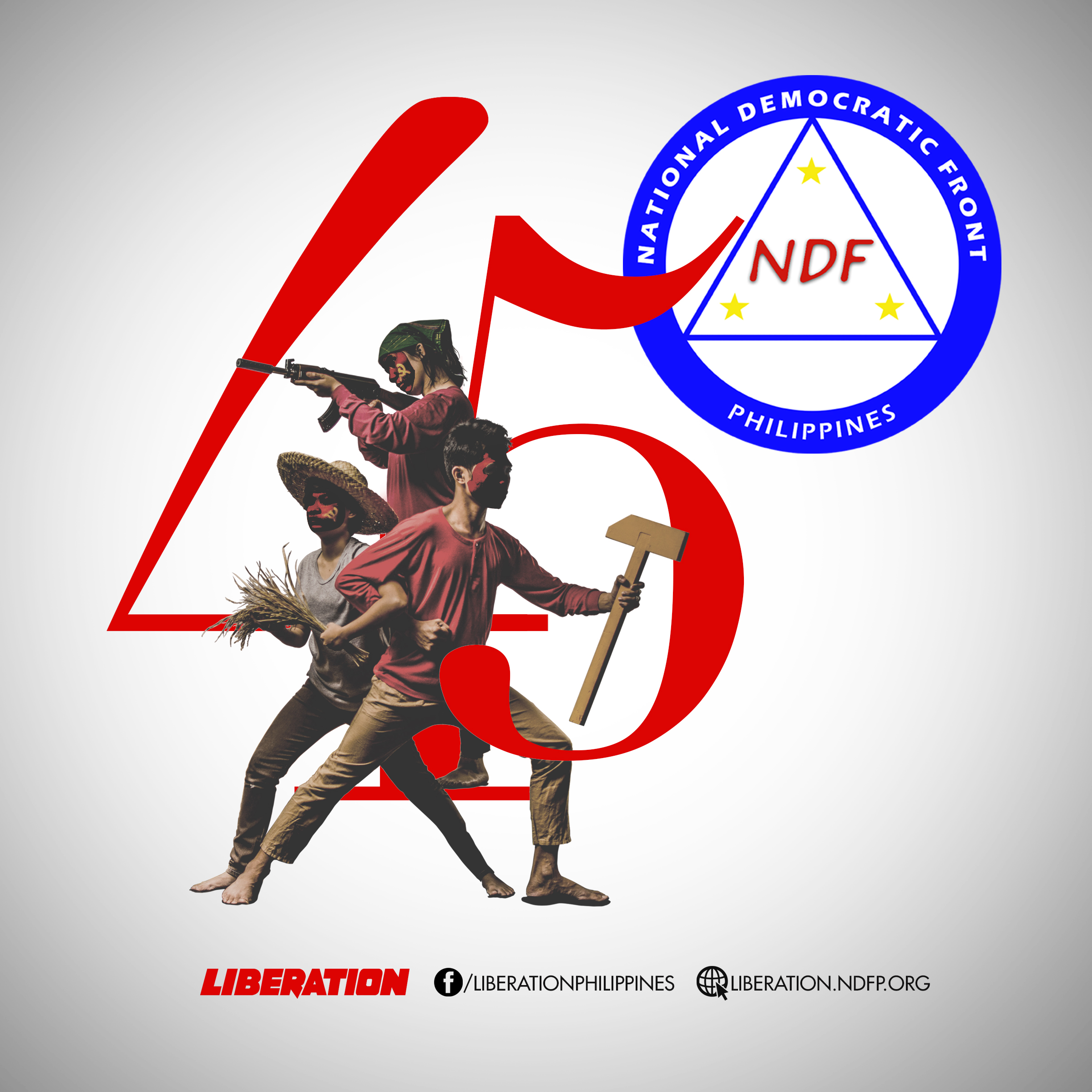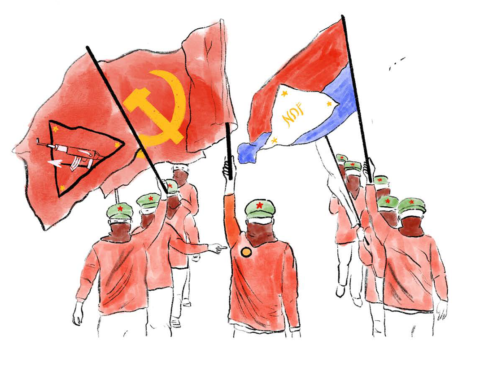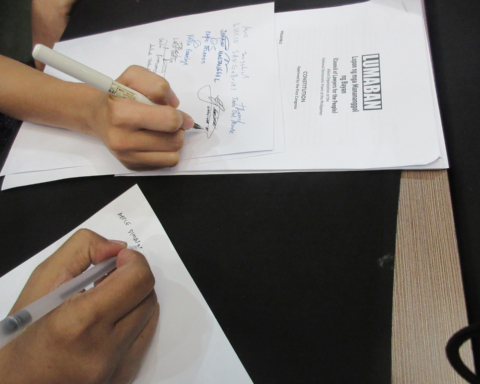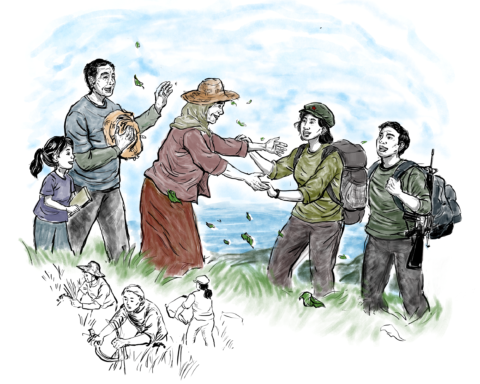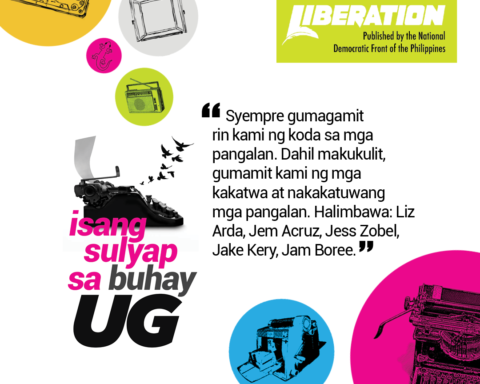by Angel Balen
On April 24 the National Democratic Front of the Philippines observes its 45th founding anniversary.
There is every reason for the revolutionary forces, mass base, allies and friends to celebrate the momentous occasion.
Today the NDFP stands justly proud, yet humble, as the veritable embodiment and official political-diplomatic representative of the consolidated national united front of the 18 allied organizations that—in nearly 50 years—have unrelentingly carried on the Filipino people’s struggle for national and social liberation.
As envisioned at its founding, the NDFP over the years has endeavored to become the most consolidated organizational expression of the unity of all the anti-imperialist and democratic forces in the country and among progressive Filipinos working/living abroad as well as solidarity groups in various countries. It is through the NDFP that national unity has been “assiduously, perseveringly developed under the class leadership of the proletariat and firmly founded on the basic alliance of the workers and peasants.”
Over almost half a century the struggle has achieved significant gains infused with the selfless martyrdom and immense sacrifices of revolutionary cadres and Red fighters.
Significant strides since the 70s
Three years ago, on the 42nd anniversary of the NDFP, Ka Oris, then the spokesperson of the NDFP-Mindanao, gave a succinct but comprehensive review of the significant developments in the national democratic revolution’s advance since 1973, with the NDFP and the New People’s Army (NPA) working together closely in 120 guerrilla fronts in strategic areas of the countryside.
Highlighting the interweaving roles of the NDFP and the NPA, under the guidance of the Communist Party of the Philippines (CPP), in building up the revolutionary forces and mass bases Ka Oris, in a video publicly shown at the anniversary celebration on August 25, 2015 at the University of the Philippines Bahay ng Alumni, declared:
“It is imperative that we remember what history has taught us: that in the advance of the NDFP, the NPA also made strides, and when the NPA and the armed struggle gained strength, the NDFP became more prestigious and its capacity to unite various political forces was amplified. This also showed that the NDFP served as the shield in the armed struggle and the NPA, as the sword to cut down the main pillar of the reactionary state. In addition, this demonstrates the NDFP’s role in waging diplomatic struggle as a weapon of [the people’s] war.
“History has shown the inseparability of the NDFP and the NPA under the guidance of the Party in advancing the national democratic revolution. The NDFP played a significant role in broadening the field of operations and the wellspring of recruits of the people’s army and the armed struggle. The NPA for its part made certain that the NDFP had a wide and deep foundation in the basic masses and that it possessed a weapon to achieve complete victory.“These victories of the NDFP must be consolidated. Let us glean our positive experiences, hold fast to them and build on them, even as we repudiate our negative experiences. We are hopeful that the revolutionary movement will continue to advance nationwide due to the socio-economic and political crisis besetting the country.
“We pledge our readiness to unite and coordinate with all forces and individuals who stand for genuine liberation, democracy, and peace based on social justice. We pledge and stake our entire strength to advancing the people’s war from the strategic defensive to the strategic stalemate and onward to total victory.”
Since Ka Oris reported on the revolution’s advances, the NDFP has earnestly been training more cadres for deployment in the ever-widening national united front work, even as it has devoted more efforts in pushing the resumption of the long-stalled GRP-NDFP peace talks under the second Aquino government and the incumbent Duterte regime.
Such work has included organizing various types of campaigns to arouse and mobilize the broad masses of the people for the revolution; promoting and building varied forms of alliances among progressive and patriotic forces towards building the broadest alliance possible against imperialism, feudalism, and bureaucrat capitalism; and building underground organizations in the urban areas.
The NDFP also has paid more attention to building revolutionary strength among the national minorities for asserting their right to self-determination and defending their ancestral domains, livelihoods, cultures and traditions. Likewise, it has improved and expanded efforts to arouse, organize and mobilize Filipino overseas migrant workers and other compatriots in various countries to contribute more meaningfully to the advancement of the revolution.
Advances in Mindanao and Visayas
On the 49th anniversary of the NPA last March 29, NDFP-Mindanao provided an update on the advances made by the revolutionary movement in that whole southern part of the country. It lauded the Red commanders, fighters, people’s organizations, and members of the People’s Militia, local guerrilla and self-defense units for “effectively carr(ying) out their revolutionary tasks of defending the people’s welfare by delivering decisive blows against the fascist forces of the US-Duterte regime.”
The Mindanao revolutionary movement, the statement noted, “has taken significant strides to bring the people’s war to a new and higher level, with the end in view of ushering in the victory of the national democratic revolution towards the country’s socialist future.”
Citing the revolutionary masses as the “weavers of the fabric of history,” the NDFP-Mindanao expressed profound gratitude to them for having “offered their good sons and daughters to take conscious and active part in the undertakings of the true army of the people, the NPA.”
With equal fervor towards allies, the NDFP Mindanao said: “We thank all our allies as well, who, throughout the years, despite the all-out vain efforts by the ruling classes and [their] reactionary government to malign and crush the revolutionary movement, have not waivered in their support.”
Backing up with data the advancement of the people’s war in Mindanao, the statement said:
“The NPA in Mindanao continues to surge in an all-round way. Despite the all-out attacks of the US-Duterte regime, the NPA is making headway in 46 guerrilla fronts in Mindanao, where its units are operating in more than 2,500 barrios in over 200 municipalities in 20 provinces in the island. In these areas, hundreds of thousands are directly organized, while tens of thousands are covered by the people’s revolutionary government (PRG) at the barrio level, and a few at municipal levels.”
“NPA platoons and companies in Mindanao are now spread all over their base areas, helping the masses to defend themselves from impending attacks of enemy forces, recovering those (areas) relatively disrupted by enemy troops, and reinvigorating revolutionary mass organizations into launching agrarian reform campaigns and participating in meaningful activities that help advance the people’s war.
“We encourage NPA units in Mindanao to make their every political and military undertaking this year as a tribute to the 50th anniversary of the reestablished Communist Party of the Philippines.”
In the Visayas, the CPP Panay regional committee has reported similar advance in the people’s war despite the intensified repressive actions by the US-Duterte regime. Julian Paisano, regional party spokesperson, reported the following:
More youths have joined the NPA, most of them from peasant families who mainly endure the burdens of poverty and class exploitation. In 2017, the NPA in Panay added one oversized platoon to its fighting forces. At the same time, more peasants have joined units of the People’s Militia which principally assume responsibility for defense and maintenance of peace and order in their respective communities and provide direct support to the fulltime units of the people’s army.
Much-improved ideological, political and organizational work within every unit of the NPA, Paisano noted, has resulted in the enhanced spirit of discipline and capacity of the fighting units in carrying out their primary tasks: base-building (done in tandem with the NDFP), agrarian reform, and launching tactical offensives (TO). Consequently, more than 20 TOs were successfully launched in 2017. These resulted in the confiscation of various-caliber firearms from the enemy, inflicting casualties (10 killed and 20 other enemy troops wounded). Three Red fighters sacrificed their lives in the encounters.
The People’s Democratic Government
For the past 32 years, reckoning from the initial GRP-NDFP peace talks in 1986-87, the NDFP has firmly stood for and carried the political authority of the people’s democratic government (PDG), constituting of the organs of political power at the barrio level, in some areas at municipal or section level.
The PDG is painstakingly being built to educate the organized masses on the principles, ways and means of collective self-governance, and to enable their democratically elected local leaders to assume responsibility and hone their leadership capabilities through practice for safeguarding and advancing the people’s welfare, while helping advance the revolutionary struggle. The perspective is for the PDG to ultimately replace the reactionary, oppressive and exploitative rule of the imperialists, the big landlords, and big bourgeois compradors.
Understandably not one of the post-Marcos dictatorship administrations of the Government of the Republic of the Philippines has shown the courage or political will to explicity recognize the PDG’s political authority—and consequently recognize the existence of dual political power in the country. They have all been wary of adopting an attitude, much less taking any action that would enhance the prospects of the revolutionary movement attaining a status of belligerency.
Nonetheless, in varying degrees, the administrations of Corazon Aquino, Fidel Ramos, Gloria Arroyo, Benigno Aquino III, and Rodrigo Duterte tacitly acknowledged the political authority of the NDFP when they acceded to sit down with the latter on the negotiating table—based on the principle of parity of status—and hammer out a just and lasting political settlement of the prolonged armed conflict.
Fidel Ramos stands out as the only GRP president who sustained (though with many interruptions) the peace negotiations throughout his term of office. Joseph Estrada (who succeeded Ramos) spurned the peace negotiations and opted for a “total war” policy. Yet he did a signal role (though he didn’t seem to have been aware of it at the time). After assuming office in 1998 Estrada, as principal of the GRP negotiating panel, signed the Comprehensive Agreement on Respect for Human Rights and International Humanitarian Law or CARHRIHL. The accord, lauded as a “landmark” document by the European Parliament, was negotiated and completed under the Ramos administration.
Rodrigo Duterte could have done better than Ramos had he been hands-on in the negotiation process—as Ramos was. He came close to signing the most substantive agreement in the peace talks that would have addressed the root causes of the armed conflict: the Comprehensive Agreement on Social and Economic Reforms (CASER), which could have been followed by the completion and signing of the Comprehensive Agreement on Political and Constitutional Reforms (CAPCR).
However, buckling under the pressure of his militarist advisers, Duterte balked. He completely turned around and arbitrarily “terminated” the GRP-NDFP peace talks in November, through Proclamation 360—although that is not the prescribed mode of formally ending the peace negotiations. Initially, he tried to justify his decision by accusing the NPA of continually attacking and killing “my soldiers and policemen.”
Later Duterte rationalized his action by claiming he couldn’t agree to share power through a “coalition government” with another political authority that he said had no mandate from the Filipino electorate. By that stance he showed a narrow, even erroneous, understanding of certain principles in peace negotiations, specifically that the two negotiating parties shall have joint/shared as well as separate responsibilities in the implementation of signed agreements.
(A “coalition government” could probably come into fruition only after a final peace accord should have been signed—which would entail the cessation of hostilities and disposition of the armed forces of both sides—and the political forces under the NDFP should have decided to participate in the elections for a new government that should see after the full implementation of all the peace agreements.)
Proscribing the CPP/NPA as Terrorist
Beyond seeking to terminate the GRP-NDFP peace talks, Duterte also issued Proclamation 374 declaring the CPP and the NPA as “terrorist organizations.” Again, no matter that it carried the president’s authority, the proclamation by itself is not legally binding. The anti-terrorism law (euphemistically titled “The Human Security Act of 2007”) on which the proclamation is based, requires the government, through its department of justice, to petition a regional trial court to declare as terrorists the two revolutionary organizations.
The procedure is called proscription, wherein the judge must hear both the side of the petitioner (DoJ) and those of the respondents (CPP and NPA). The court must find as sufficient and verified to be factual the documentary or testimonial evidence submitted by the DoJ to satisfy the grounds, specified under the Human Security Act, before it can issue a ruling declaring the CPP and NPA as terrorist organizations.
The petition has already been challenged, in a motion filed by Saturnino C. Ocampo, one of the persons whose names are listed in the petition as allegedly the “known officers” of the CPP-NPA with known addresses. Besides refuting the imputation that he is a “terrorist” and the allegation he is an officer of the CPP-NPA, Ocampo urges the court to dismiss the petition because it fails to satisfy the stiff requirements of the Human Security Act in determining if an organization is in fact terrorist.
It is important to note that both in Proclamation 374 and in the judicial petition, the Duterte regime isn’t seeking to tag the NDFP as a terrorist organization along with the CPP and the NPA, which are its two leading affiliate organizations. One can only speculate on the reason(s) behind the exclusion/omission.
Reminiscent of Martial Law
Another important point to note is that the NDFP celebrates its 45th anniversary under political conditions eerily reminiscent of those prevailing at the time it was founded: seven months after Ferdinand E. Marcos had declared martial law nationwide and installed himself as fascist dictator for nearly 14 years.
Martial law has been in effect in the whole of Mindanao for over a year now. It was originally intended to enable the reactionary state’s security forces to quell an alleged rebellion in Marawi City by Muslim militant groups which the US and the Philippine governments associate with the Islamic State. After that was accomplished, largely with aerial bombings guided by American spy planes and drones that destroyed much of Marawi, Duterte had the martial rule extended until the end of 2018, adding the NPA as its target for annihilation. He has threatened, should the NPA further escalate its counteroffensives against the state forces, to declare martial law nationwide.
In this regard, the NDF-Mindanao statement on March 28 described the US-Duterte regime as “seething with fascism, employ(ing) militarism and other draconian measures to suppress any and all forms of opposition and dissent.” Leaders and members of legal and legitimate mass organizations have become targets of brutal attacks, warrantless arrests and filing trumped-up charges, detention and torture, surveillance and profiling of targeted individuals, enforced disappearance and extrajudicial killing.
Moreover, of the more than 600 names and aliases listed as “officers and members” of the CPP-NPA in the proscription petition filed in court by the DoJ, more than half of them are allegedly from Mindanao.
The regime, the statement added, seeks to wipe out the NPA by the end of 2018 through Oplan Kapayapaan, which employs “vile military and psywar tactics rehashed from previous failed operation plans.”
To create in the public mind a false perception that these tactics have been succeeding, the AFP/PNP has resorted to “subterfuge, perfidy and black propaganda.” They orchestrate the murder of civilians, make it appear like it was executed by “terrorists” and impute the crime on the NPA. Then through trolls, the statement noted, the US-Duterte regime poisons both the social and mainstream media with such false news.
The AFP has also stage-managed the gathering of hundreds of fake surrenderers in Davao City and flew them to Manila aboard military transport planes, for touring at the Luneta and other urban tourist spots, capped by dinners at Malacanang with President Duterte. Duterte has even offered the women “surrenderers” government-funded tours in Hong Kong and China so they could observe firsthand the economic progress supposedly achieved after the former “socialist China” embraced the capitalist road to development.
Following the issuance of Proclamation 374, the statement pointed out, Duterte has gone further to “almost sociopathic proportion” as to offer P25,000 to P100,000 bounty for every NPA fighter killed and to order that women Red fighters who may be captured be “shot in their vaginas to render them useless.”
Also it must be noted that, against strong popular protests, in November 2017 Duterte rammed the political rehabilitation of the deposed dictator Marcos by facilitating the burial of his remains at the Libingan ng mga Bayani. Now he appears to be implacably set to replicate the prolonged Marcos tyrannical rule, using as conveyance, through charter change, a shift in the form of government from the current unitary to a federal type that is yet to be fully defined.
The looming restoration of that reviled fascist dictatorship invests the observance of the NDFP’s 45th anniversary with an urgent popular behest: Resist the rising tyranny of the US-Duterte regime; sustain the gains of the National Democratic Revolution!


